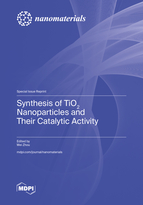Synthesis of TiO2 Nanoparticles and Their Catalytic Activity
A special issue of Nanomaterials (ISSN 2079-4991). This special issue belongs to the section "Synthesis, Interfaces and Nanostructures".
Deadline for manuscript submissions: closed (31 July 2023) | Viewed by 20178
Special Issue Editor
Interests: porous photocatalytic nanomaterials for solar energy conversion; energy and environmental applications
Special Issues, Collections and Topics in MDPI journals
Special Issue Information
Dear Colleagues,
Due to the increasingly polluted environment and the gradual depletion of fossil fuel reserves, the development of renewable technologies for environmental remediation and energy production is highly desirable. Over recent decades, oxide-based semiconductor photocatalysis has attracted much attention. Among various oxides, TiO2 nanomaterials are most ideal because of their high stability, low price, high activity, and environmental compatibility. Due to the large external surface and higher dispersion on the surface, the photocatalytic activity of TiO2 nanoparticles is usually much higher than that of bulk particles. However, nanosized semiconductor particles are usually aggregated and possess quantities of surface defects, which are usually unfavorable for photogenerated charge separation. In addition, the large bandgap of TiO2 (3~3.2 eV) limits the utilization ratio of solar light. The rational design of TiO2 architecture (including morphology, surface defect engineering, doping, heterojunction, etc.) is of great importance to enhance photocatalytic performance.
This Special Issue will present comprehensive research outlining progress on the fabrication and application of TiO2 nanostructures. We are pleased to invite you to contribute original and review articles regarding TiO2 nanomaterials for catalytic applications. In this Special Issue, original research articles and reviews are welcome. Research areas may include (but are not limited to) the following:
- Photocatalytic water splitting;
- Photocatalytic environmental remediation;
- Defective TiO2 nanomaterials;
- Porous TiO2 nanomaterials;
- TiO2
We look forward to receiving your contributions.
Dr. Wei Zhou
Guest Editor
Manuscript Submission Information
Manuscripts should be submitted online at www.mdpi.com by registering and logging in to this website. Once you are registered, click here to go to the submission form. Manuscripts can be submitted until the deadline. All submissions that pass pre-check are peer-reviewed. Accepted papers will be published continuously in the journal (as soon as accepted) and will be listed together on the special issue website. Research articles, review articles as well as short communications are invited. For planned papers, a title and short abstract (about 100 words) can be sent to the Editorial Office for announcement on this website.
Submitted manuscripts should not have been published previously, nor be under consideration for publication elsewhere (except conference proceedings papers). All manuscripts are thoroughly refereed through a single-blind peer-review process. A guide for authors and other relevant information for submission of manuscripts is available on the Instructions for Authors page. Nanomaterials is an international peer-reviewed open access semimonthly journal published by MDPI.
Please visit the Instructions for Authors page before submitting a manuscript. The Article Processing Charge (APC) for publication in this open access journal is 2900 CHF (Swiss Francs). Submitted papers should be well formatted and use good English. Authors may use MDPI's English editing service prior to publication or during author revisions.
Keywords
- photocatalysis
- porous nanomaterial
- defect engineering
- solar energy conversion
- mesoporous TiO2
- black TiO2
- heterojunction
- water splitting







